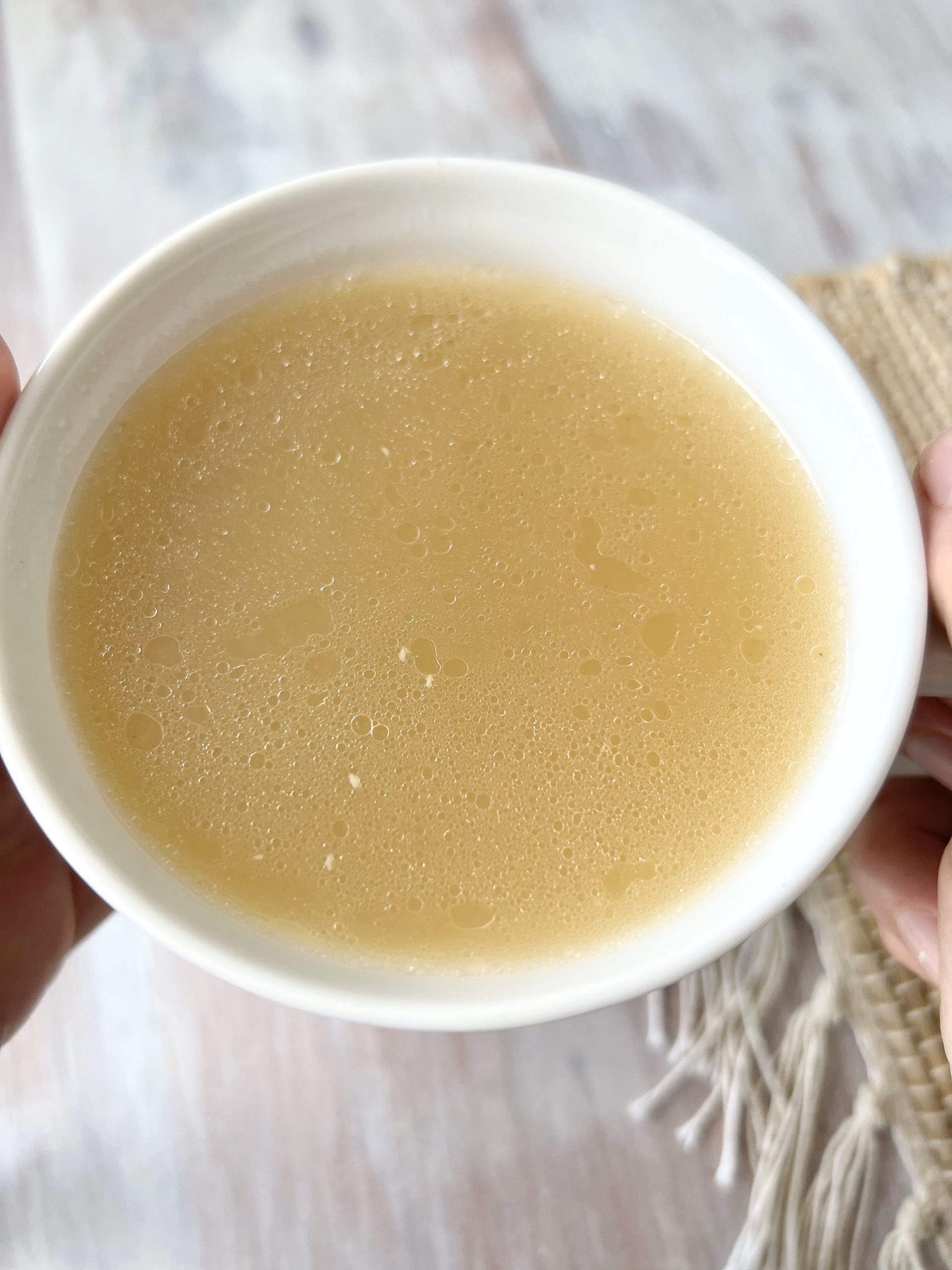Restorative and nourishing, bone broth is everywhere these days and understandably so. It’s affordable, packed with nutrient dense minerals, age-defying collagen, and easy to make at home in either your Instant Pot, slow cooker, or in a stockpot on the stove.
Bone broth (or stock) is an ancestral food that’s been around for ages, literally. In short, it’s a liquid made from simmering bones in water over a period of time. Drinking bone broth on its own, or using it as a base for soups and other dishes, is a great way to get its health benefits such as supporting digestive health, joint health, a healthy immune system, and more. Bone broth contains many important nutrients, including amino acids, collagen, and protein. Keep reading below to learn about the top 5 benefits of bone broth and how you can make your own bone broth at home.
The Top 5 Benefits of Bone Broth:
Amino acids, the building blocks of proteins in our cells and tissues, are one of the main components of bone broth. Proteins are used within the body to perform many bodily functions as well as repair, build, and grow bodily tissues. Research indicates that the components of bone broth can benefit the body from head to toe, from mental health to skin health.
1. Brain health
Bone broth is a good source of the amino acid glycine, which plays a key role as a neurotransmitter (messenger between nerves and cells), influencing brain development, motor skills, and behavior. Glycine also has anti-inflammatory and antioxidant properties. Research demonstrates that glycine can decrease neurological (brain and spinal cord) damage related to oxidative stress in mice. Cellular damage related to oxidative stress can negatively affect the nervous system, potentially playing a role in the development of neurological diseases such as Alzheimer’s disease and Parkinson’s disease.
2. Gut health
Beef bone broth is rich in the amino acid glutamine, the most abundant and widely used amino acid in the body. About 30% of total body glutamine is used by the digestive tract to support intestinal health. Its functions include supporting a healthy inflammatory response, maintaining the intestinal barrier, and regulating intestinal cell death. In gut health conditions such as inflammatory bowel disease and IBS, glutamine levels are significantly lower than healthy individuals. Regularly drinking bone broth may help increase glutamine levels to support digestive health.
3. Immune health
Not only is glutamine a key nutrient for a healthy gut but also a healthy immune system. Leukocytes (white blood cells) require glutamine for proper function. During illness or injury, glutamine is used by the immune system just as much, if not more, than glucose (sugar), the main source of energy for the human body. Glutamine can be created within the body, but levels are often insufficient during times of illness. Research indicates that supplementing with glutamine before or after a major health event, such as bone marrow transplantation, radiation treatment, or surgery, may be beneficial for immune health.
4. Joint health
Joint pain related to osteoarthritis (joint damage) is one of the most common causes of chronic pain, affecting millions of North Americans. Osteoarthritis occurs when joint cartilage (tough, flexible tissue) degrades, causing bones to scrape against each other as the joint moves. This can eventually cause pain and negatively impact all areas of connective tissue, including bone, cartilage, ligaments, and tendons. Collagen is the main structural protein found in skin and other connective tissues, such as cartilage. Collagen can be synthesized in the body using amino acids, or obtained from dietary or supplement sources. Consuming more collagen and collagen-building amino acids and nutrients may be one way to promote bone and joint health. Bone broth is a good dietary source of collagen and collagen-building amino acids. Clinical and animal research has demonstrated that supplementing with collagen extract derived from bones, like that from chicken or beef bone broth, may be effective for decreasing joint pain.
5. Skin health
Skin, the body’s largest organ, contains up to 70% of collagen, which plays an important role in maintaining skin structure and elasticity. Aging reduces collagen production within the body, which can weaken skin elasticity and strength, causing the skin to become thin, dry, and wrinkled. Research suggests that collagen is a major component in the “anti-aging” of skin. Bone broth collagen may be just what your skin needs for a youthful glow.
Homemade Bone Broth
Making bone broth at home on the stovetop or in a slow cooker is the best way to get its amazing health benefits. Not only is homemade bone broth more nutritious than store-bought varieties, but it’s also more cost effective, reduce exposure to plastics and preservatives AND you can control the ingredients. A study reported that store-bought bone broth was found to be lower in all amino acids than the self-prepared varieties. While it may sound a bit daunting if you’ve never done it before, trust me making your own bone broth is actually quite simple! Next time you roast a chicken at home save the bones and try making your own broth. You can also get bones from your local butcher or most grocery stores. My favorite is to use either beef bones such as Oxtail, a leftover chicken carcass from roasting a chicken or lamb shanks.
The best bones for bone broth (beef, lamb or chicken bone broth) include:
- Knuckles
- Joints
- Feet
- Marrow bones
- For added flavor incorporate meaty bones like oxtail, shank, and short ribs.
- Chicken feet (not included in this recipe) contain loads of gelatin and are less expensive than other gelatin-rich bones.
- Though not bones, I like to add organ meat to my bone broth recipe. Often I will add the chicken heart, liver and other organs that come with the organic chickens that I buy. I like to include them in my broth to boost the nutrient profile and enrich the flavor of the broth.
A Note on Blanching and Roasting
Blanching the bones in water for 15-20 minutes helps remove any impurities, coagulated protein, and blood which ultimately results in a clearer broth. The extra protein and blood won’t hurt you by any means and can be easily skimmed off the top of your broth while simmering, however some people prefer to blanch the bones ahead of time in order to make a clearer broth. Do you have to blanch the bones? The answer is no. However, if you’re making broth from beef bones, then you may want to blanch them first if you want a clearer broth. If you’re using chicken bones or are fine to skim any foam off the top then it’s less important.
Same goes for roasting. Some recipes call for blanching the bones then roasting them with onion, carrot and celery in the oven before simmering. The purpose of this is to intensify the flavor of the broth. Personally I don’t do either of these steps unless I’m using the broth to make something specific like Pho soup. The majority of the time I like to keep it simple and follow the recipe below.
Here’s my recipe:
Ingredients:
3-4lbs chicken or beef bones (*if possible try to purchase organic, grass-fed or pastured animal bones. This guarantees a more nutrient rich broth free of added hormones and antibiotics.)
10-12 cups of filtered or spring water (add more if needed to cover bones in pot)
1 large organic carrot washed and roughly chopped
2 organic celery ribs washed and roughly chopped
1 large onion quartered
2 garlic cloves
2 bay leaves
1 tsp sea salt (add more to taste if you like)
1 Tbsp apple cider vinegar
7 whole black peppercorns
Method:
1. Place all ingredients in a 10 quart capacity slow cooker or large stock pot on the stove. Add in water.
2. Turn on the slow cooker and prepare to cook for at least 24-36 hours, so that might mean 2-3 cycles on the standard slow cooker that has a maximum 12-hour setting (unless you can set your slow cooker for longer).
3. If cooking on a stovetop, bring a large pot to a boil over high heat; reduce and simmer gently.
4. In a slow cooker or pot, skim the fat and foam that rises to the surface occasionally.
5. Simmer for at least 10-12 hours. You can simmer for much longer, up to 48 hours if you wish. The longer you simmer your broth, the more minerals and nutrients you will extract from the bones. I typically put my broth on to cook in the morning and let it simmer gently all day long on the stovetop if I’m using chicken bones or lamb shank. For larger beef bones I like to use my slow cooker and let them simmer for 24-36 hours.
6. Once done simmering, remove from heat and allow to cool slightly.
7. Discard solids and strain remainder in a bowl through a colander. Let stock cool to room temperature, cover in a reusable glass container and chill.
8. Refrigerate and use within a week. Or freeze for up to 3 months.



